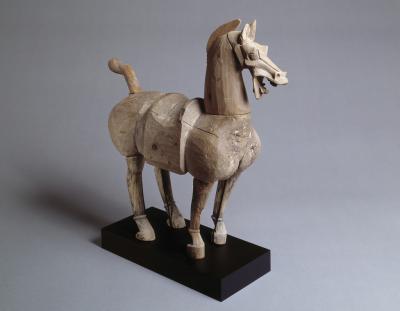
Horse
Artist not known, China
25–220 A.D., Eastern Han Dynasty
Height: 24.75 in. Width: 26 in.
Gift of Nathan Rubin-Ida Ladd Family Foundation under the bequest of Ester Rubin Portnow, 1999.276
Photograph © Denver Art Museum 2009. All Rights Reserved.
This horse was carved by an artist in China during the Eastern Han dynasty (25–220 A.D.). While the origin is not known for certain, it may have come from a tomb in Wuwei, a desert city in northwest China. Scholars have estimated the date and location of the horse by comparing the style to other horse sculptures of the same period. Art of the Eastern Han dynasty focuses on movement and expression. Sculptors often carved figures using angular and geometric forms, rather than clearly defined muscles. This horse is made of many pieces of wood that were carved separately and then joined together. Since wood tends to break parallel to (not across) the grain, the artist carved individual pieces so the grain of the wood follows the length of the carved piece. Wood is valued in the East for its beauty of grain, fragrance, strength, and elasticity. Wood, not stone, was used to build palaces, temples, and other grand buildings. The wood of this horse is amazingly well preserved for being almost 2,000 years old. This tells us it was probably buried in a region with a dry climate.
Horse sculptures like this one were commonly used in China as mingqi [MING-chee], or tomb goods, and were buried in tombs. Mingqi were objects meant to be used in the afterlife. They symbolized immortality and high status, commemorated and recorded the life of the deceased, and displayed the devoutness of the children or relatives of the deceased. The horse was a symbol of immortality. According to Chinese lore, the mythical Emperor Huangdi achieved immortality by ascending Mount Kunlun, the home of the immortals, on the back of a winged creature that is often described as a horse. During the beginning of the Han dynasty, the horse became associated with the dragon and was assigned supernatural qualities such as the ability to fly. Horses were also important in building the cavalry, the most important line of military defense at the time. In short, the horse represented an ideal and became a metaphor in art and culture for its strength, power, potency, speed, grace, and beauty.
Details
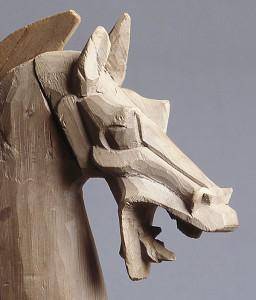
Facial Features
Note the sharp features of the face and flared nostrils, compared to the softer curves of the body.
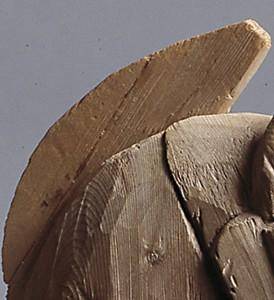
Mane
The cropped mane is a crescent-shaped, flat piece of wood that has been inserted into a slot carved into the horse’s neck.
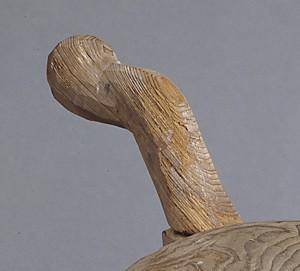
Tail
The short, cropped tail is a Han dynasty characteristic.
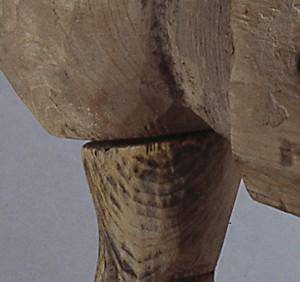
Dry Wood
Notice the underbelly of the horse where the wood has dried and cracked.
More Resources
Websites
The Vibrant Role of Mingqi in Early Chinese Burials
Essay "The Vibrant Role of Mingqi in Early Chinese Burials," from the Metropolitan Museum of Art's Heilbrunn Timeline of Art History. Discusses Chinese burial figurines, with images of other mingqi.
Ancient China
Interactive website from the British Museum, with stories, timelines, games, and challenges.
Smithsonian Chinese Art Teacher Resources
This website features online exhibitions, teacher guides, lesson plans and resources on Chinese art from the collections of the Smithsonian's Freer and Sackler galleries.
The National Consortium for Teaching About Asia
A web resource for elementary and secondary teachers.
The Asia Society
This multi-media website offers lesson plans, maps, images, and other resources for teachers interested in Asia.
The Han Dynasty
Essay "The Han Dynasty," from the Metropolitan Museum of Art's Heilbrunn Timeline of Art History. Includes images, timelines, and other resources.
Chinese Tombs
Website with information about Chinese tomb treasures of the Han dynasty, with timelines and images.
Denver Art Museum Wacky Kids
Learn about a Chinese Dragon Robe, with activities and a list of related books.
Books
Clunas, Craig. Art In China. New York: Oxford University Press, 2009.
Concise Chinese art history textbook, from the Neolithic through the 20th century.
Sullivan, Michael. The Arts of China. Berkeley, CA: University of California Press, 1999.
Overview of Chinese art history through the 20th century.
White, Julia M. and Ronald Y. Otsuka. Pathways to the Afterlife: Early Chinese Art from the Sze Hing Collection. Honolulu, Hawaii: University of Hawaii Press, in association with the Denver Art Museum, 1993.
This book discusses Chinese burial art from the Neolithic period through the Liao dynasty, with information about burial objects of the Han dynasty.
Children's Books
Michiko, Debbi Florence. China: Over 40 Activities to Experience China...Past and Present. Nashville, TN: Williamson Books, 2008.
Children ages 9-12 can read and learn about China, as well as try their hands at such activities as calligraphy and feng shui.
Funding for object education resources provided by a grant from the Morgridge Family Foundation. Additional funding provided by the William Randolph Hearst Endowment for Education Programs, and Xcel Energy Foundation. We thank our colleagues at the University of Denver Morgridge College of Education.
The images on this page are intended for classroom use only and may not be reproduced for other reasons without the permission of the Denver Art Museum. This object may not currently be on display at the museum.
